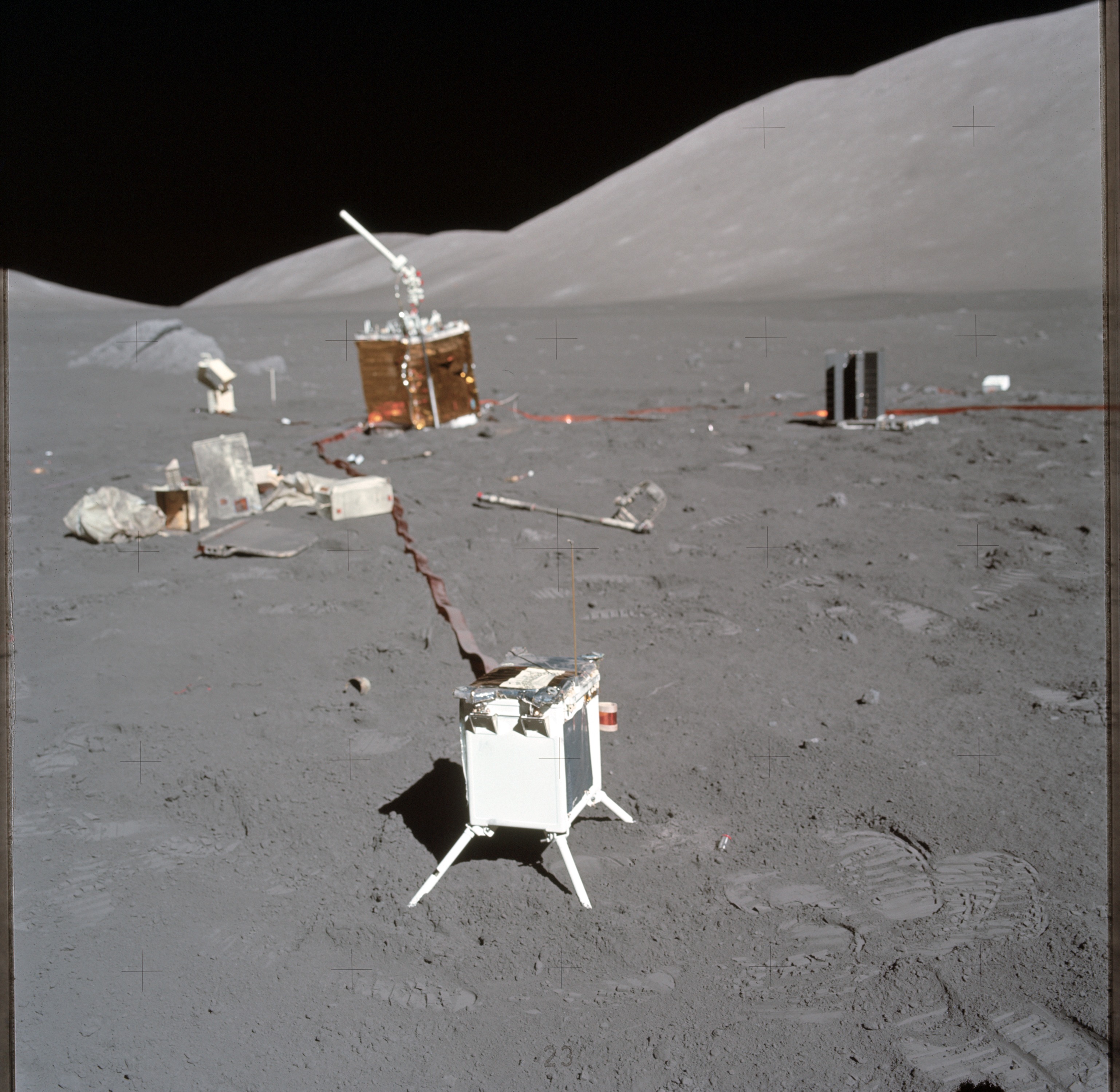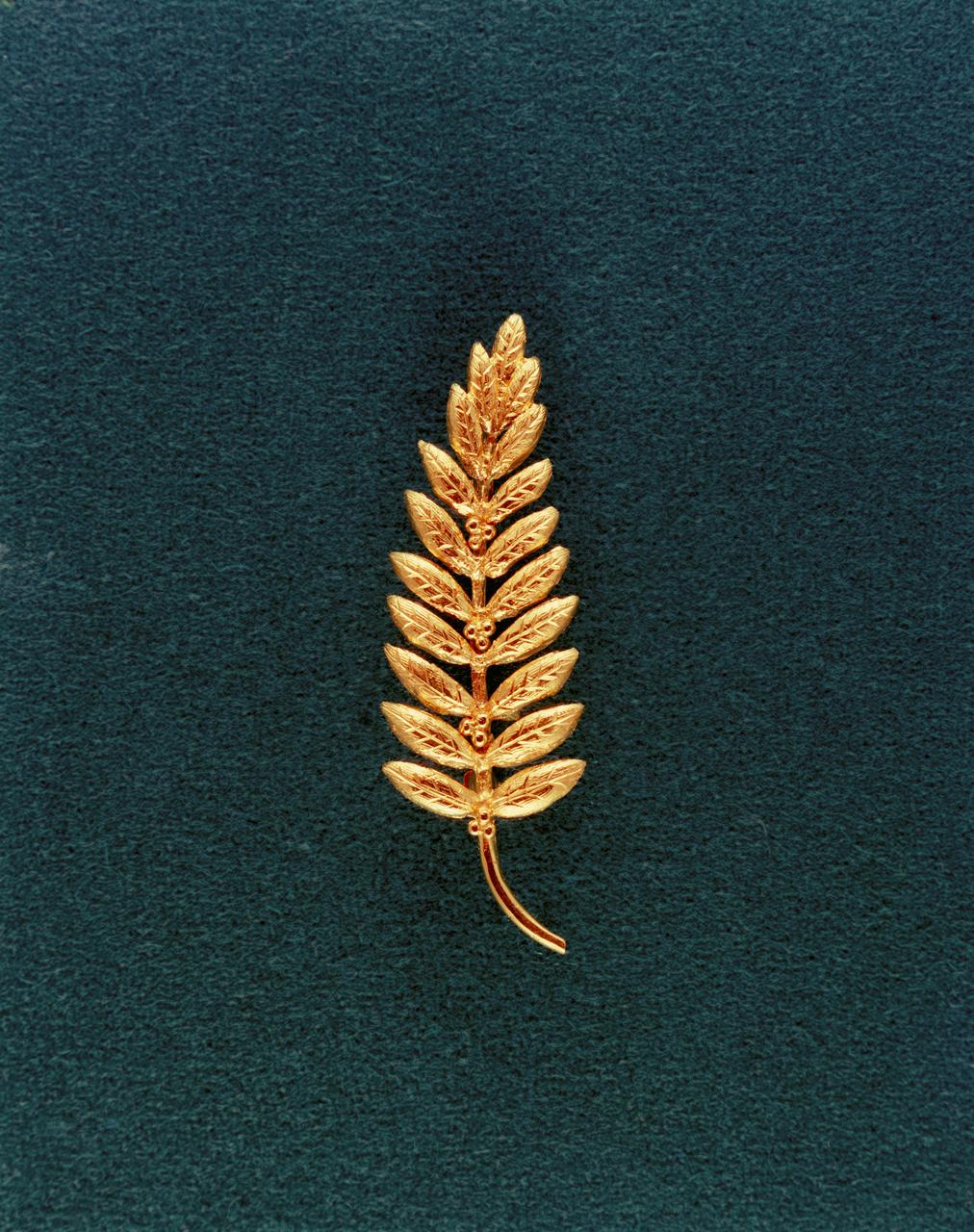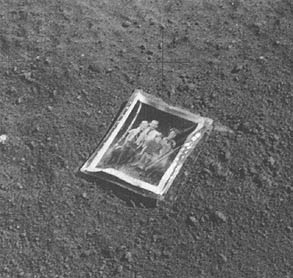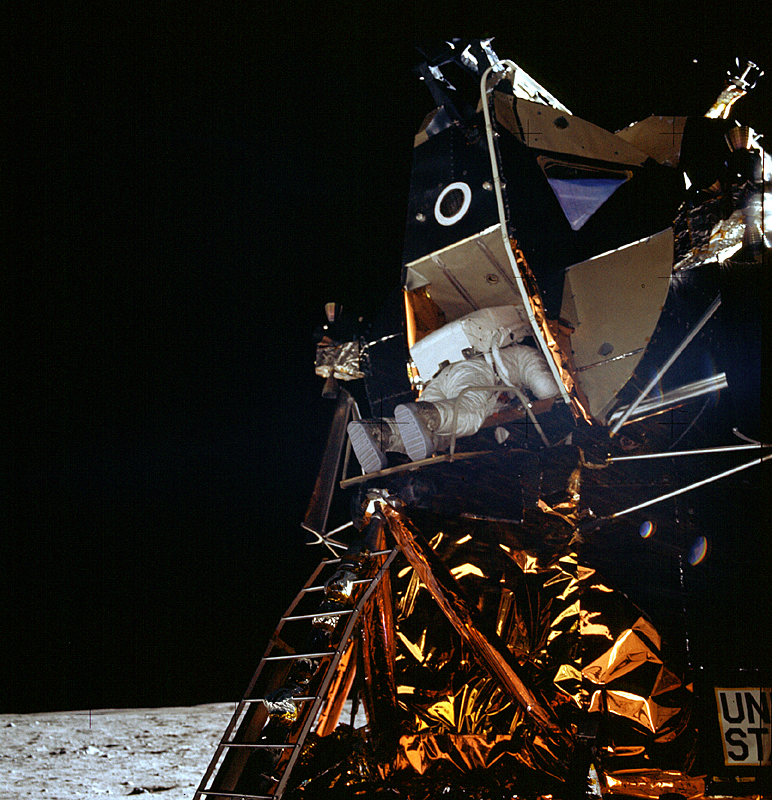The Weirdest Things Apollo Astronauts Left on the Moon
To throw things away is human.

Three golf balls. A family photo. Large pieces of scientific equipment. A tiny statue. Bags and bags of human waste of one flavor or another. And of course, American flags. It's all among the stuff that the dozen astronauts who walked on the moon between 1969 and 1972 left behind.
Nearly half a century later, the motley collections are still there, although it's unlikely time has been kind to the objects scattered across the six landing sites. Some of the objects were deeply meaningful, sent to the moon expressly to be left there. But pragmatism in part guided the decision to leave terrestrial material behind: The more stuff the astronauts discarded, the logic went, the more weight they freed up for bringing moon rocks back to Earth.
"There is debris, there's symbolic artifacts that didn't have to be left there, there's some just amazing scientific stuff," Beth O'Leary, an archaeologist and anthropologist focused on space at New Mexico State University, told Space.com. And there are some mysteries, too. "You would think that NASA has a complete inventory — they send up things, they come back and they count them all and everybody knows what's there and what's not there — and that's not necessarily true."
Related: Apollo 11 at 50: A Complete Guide to the Historic Moon Landing
- Relive the Apollo 11 Moon Landing Mission in Real Time
- Apollo 11 Moon Landing Giveaway with Simulation Curriculum & Celestron!
- Moon-Landing Hoax Still Lives On, 50 Years After Apollo 11. But Why?
O'Leary should know: she is one of a team who worked to compile all the objects left behind by astronauts Neil Armstrong and Buzz Aldrin during the Apollo 11 landing. All told, the group identified an eclectic list of 106 objects, plus the footprints marking Armstrong and Aldrin's steps.
The largest items, at the Apollo 11 site and its successors, were at the scientific and engineering heart of the program. Each site boasts the descent stage of its lunar module, for example, which served as a launch pad for the astronauts heading home. Scientific experiments are also scattered across each landing site: seismometers to hunt moonquakes and retroreflector mirrors to pinpoint the distance from Earth to moon, plus smaller apparatuses as well.
Astronaut mementos
Some of the abandoned items were carefully chosen, ceremonial objects. Apollo 11, for example, carried not just the famous flag the astronauts planted. The lunar module sported a commemorative plaque honoring the landing and the mission also carried a silicon disk inscribed with comments from the leaders of 74 countries. The astronauts may have brought medals to commemorate dead Soviet cosmonauts. And they also brought a small gold olive branch, a millennia-old emblem of peace.
Breaking space news, the latest updates on rocket launches, skywatching events and more!
Later Apollo missions weren't quite as straight-laced. Among the silliest items left on the lunar surface are three golf balls, which Apollo 14 astronaut Alan Shepard swung across the moon.
"You can look at the golf balls and say, well, that was kind of about a bit of fun," Alice Gorman, an archaeologist at Flinders University in Australia who focuses on space, told Space.com. "It was kind of experimental: How would you play golf on the moon in such a different gravity? But it was also a little bit playful."
Another astronaut was inspired to leave his trace in a very different way: during Apollo 16, Charlie Duke left a signed photograph of his family tucked in a plastic sleeve on the moon's surface. "That's a lovely one to me because it's so personal; it's kind of a gesture of wanting, by leaving their photograph there he's kind of enabling them to share that experience of being on the moon in some way and also sort of commemorating them as a family," Gorman said.
But a future moon explorer will likely never see the faces of the Duke family, she said. Even on Earth, photographs fade to blue under ultraviolet light, and there's much more of that light on the moon — not to mention a steady hail of micrometeorites that could destroy the print.
All of these objects were extras, so to speak, not part of the Apollo necessities. "They're taking an artifact which doesn't have any other function in the context of the mission and using it to express some kind of quite human relationship," Gorman said.
Lightening the load
The astronauts left many objects behind out of necessity. For O'Leary, one of the most compelling moments of Apollo 11 came when Armstrong and Aldrin were preparing to return home.
"For about 8 minutes, they stood on the corner of the [lunar module] and tossed out anything that was not important, because this was the first time and they were told to jettison anything that they did not need," she said. "They created what in archaeology is called a 'toss zone.'"
The Apollo 11 crew and their successors created an archaeological site the same way humans have done for millennia, Gorman said, and the same process of looking through waste that has led to a better understanding of our past here on Earth can also help us understand the moon missions.
The excess weight jettisoned before leaving the moon included some objects that were crucial to the Apollo 11 mission but had outlived their usefulness. Those objects shaped the mission's legacy, like the tube that carried the flag and the television camera that Armstrong and Aldrin had used to share their historic moment with more than half a billion humans watching from Earth, a late addition to the flight. Sampling tools like scoops and tongs were abandoned, their purpose served.
"The thing of low value was replaced with the thing of high value, and in that process of choosing what can be chucked out you find out what's expendable," Gorman said. "They've chucked out things like armrests from inside the capsule, so in that level, comfort is not the highest priority. The highest priority is getting all of those samples back, getting them back safely as well."
Astronaut poop on the moon
And then, of course, there's that human waste.
Apollo 11 left behind four urine collection assemblies and four emesis bags. "That's really the opposite end of the spectrum to these carefully chosen and carefully placed objects, it's literally the bag of poo just flung out of the spacecraft," Gorman said. "But in some ways, it encodes as much, if not more, information because human body residues are rich in information about the diet of those astronauts in space and the effect on their bodies."
Revisiting the bags after their long years on the moon's surface could also help scientists understand how the harsh lunar environment would affect a human body, she said, turning them into after-the-fact experiments of a sort.
For now, scientists can't be sure about the condition of most of the other objects abandoned on the moon during the Apollo program, either. NASA's Lunar Reconnaissance Orbiter has spotted the shadows cast by lunar modules, however, so those at least must remain standing. Everything that NASA intended to send was space-hardened, designed to withstand the harsh environment, but only for the mission, not for decades. And all the extras that humans brought on their own are weaker.
But whatever the condition, they offer a very different perspective on the Apollo program than we may be used to considering, both archaeologists said.
"They really say to me it was certainly more than just a scientific expedition or a voyage of exploration," O'Leary said. "It was certainly part of the Cold War history, but it was also about taking human behavior onto a celestial body no one had ever been before. We take our culture with us, we take our ideas and our hopes and aspirations anywhere we go."
- Catch These Events Celebrating Apollo 11 Moon Landing's 50th Anniversary
- NASA's Historic Apollo 11 Moon Landing in Pictures
- Reading Apollo 11: The Best New Books About the US Moon Landings
Email Meghan Bartels at mbartels@space.com or follow her @meghanbartels. Follow us on Twitter @Spacedotcom and on Facebook.

Meghan is a senior writer at Space.com and has more than five years' experience as a science journalist based in New York City. She joined Space.com in July 2018, with previous writing published in outlets including Newsweek and Audubon. Meghan earned an MA in science journalism from New York University and a BA in classics from Georgetown University, and in her free time she enjoys reading and visiting museums. Follow her on Twitter at @meghanbartels.





